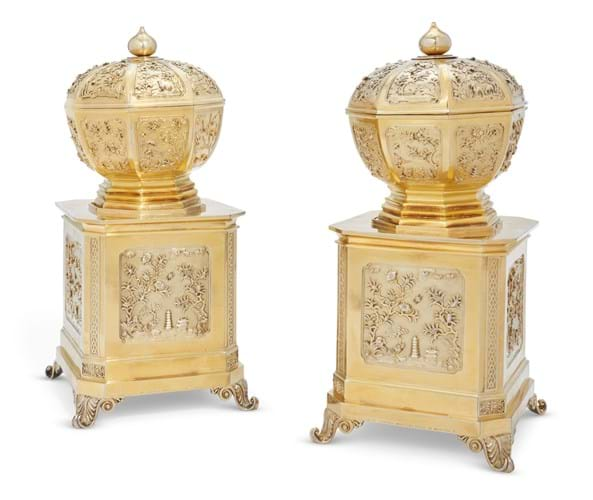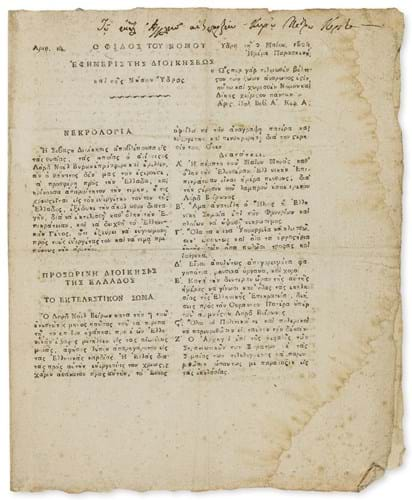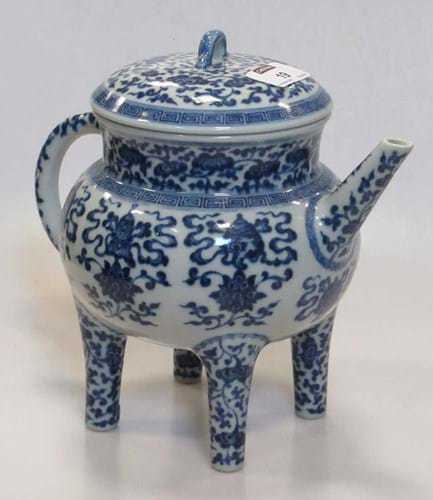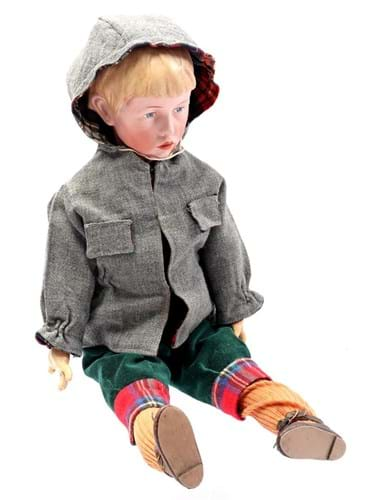
A Regency silver gilt chinoiserie garniture including a Chinese bowl and cover c.1730 – £190,000 at Christie’s.
1. Chinoiserie garniture – £190,000
This silver gilt chinoiserie garniture, above, would not have looked out of the place at the Brighton Pavilion. It combines a single Chinese octagonal bowl and cover c.1730 with a matching bowl and a pair of silver gilt plinths made almost century later by Paul Storr (London 1810).
Together they stand 15in (38cm) high and weigh 227oz.
Working for the retailer Rundell, Bridge & Rundell, Storr made a fine copy of the Chinese exemplar, replicating its onion-shaped finial and the chased decoration of figures in landscapes with birds, animals and flowers. The plinths are engraved with a coat-of-arms for Thomas Reynolds Moreton, 4th Baron Ducie, later 1st Earl of Ducie, (1776-1840) and his wife Lady Frances Herbert, daughter of Henry Herbert, 1st Earl of Carnarvon, whom he married in 1797.
The bowl has a more exotic history than most pieces of Chinese export silver which arrived directly in Britain on East India Company ships. As suggested by the inscription 'This Font was taken from the Cathedral Church of Lima', it had made its way to the Spanish colonial viceroyalty of Peru before it came to be in the London workshops of the royal goldsmiths.
Owned by the 4th Baron Ducie from the early 19th century, the garniture was passed by descent to the 6th Earl before they were sold at Christie's in 1959 (£360) and at Sotheby’s in 1964 (£2800). Acquired by the owner’s family from Thomas Lumley, London, they were consigned to the Christie’s London online sale The Collector from outside the UK and accordingly incurred an extra 5% import duty on the hammer price.
Chinese export silver from the early 18th century is much scarcer than its 19th century equivalent. Around £50,000-80,000 was expected for this lot but when bidding closed on February 8 it had reached £190,000.
2. Chinese blue and white ewer – £23,000
This blue and white ewer, offered at Cheffins in Cambridge as part of an Interiors sale on February 20, is of a type modelled on an archaic Zhou bronze ritual wine vessel or ‘He’.
It is decorated with stylised lotus blossom and the ‘Bajixiang’, the eight Buddhist emblems in order; flaming wheel, conch shell, umbrella, canopy, lotus, vase, double fish and endless knot above lotus sprays.
Vessels of this type appear to have been popular in the Qing court where ancient objects were particularly revered. Several examples with Qianlong (1730-96) seal marks have appeared for sale in London, New York and Hong Kong with another of this design with a Qianlong seal mark is illustrated in Porcelain of the National Palace Museum, Blue and White Ware of the Ch'ing Dynasty.
Cheffins catalogued its ewer, with a Qianlong mark and break to the rim (two pieces broken and replaced) as a later copy but at least some bidders begged to differ. It reached £23,000.
3. Greek journal featuring Byron’s death – £7000

Issue number 14 of The Friend of the Law Journal of the Government and Island of Hydra – £7000 at Forum Auctions
The sale of Fine Books, Manuscripts and Works on Paper at Forum Auctions in London on February 10 included this rare item of Byroniana – issue number 14 of The Friend of the Law Journal of the Government and Island of Hydra issued on May 2, 1824.
Byron’s revered status in Greece is epitomised in this bifolium and a single sheet printed in modern Greek only a few weeks after his death at Missolonghi on April 19th, 1824. The text includes a number of decrees from the Greek government including the observation of a day of mourning for ‘our brilliant supporter’ on May 5, the flying of flags at half-mast and an 11-gun salute from the main forts and three broadsides from every armed vessel. It has a stamp for the Nottingham Public Library and an ink inscription at head of the first page.
As an item missing from many Byron collections, it was estimated at £300-400 but took £7000.
4. German doll from c.1910 – €9000
This rare bisque socket head doll was made by Kammer and Reinhardt as part of its art character series, c.1910.
The Kämmer and Reinhardt doll company was formed in 1886 in Waltershausen, Thüringia, Germany by Ernst Kämmer and Franz Reinhardt. As revealed by scholars in the 1990s, it seems the head of a stern-faced boy was modelled by the Berlin-based artist Arthur Lewin-Funcke and was based on his bronze sculpture Portrait of a Boy. The doll with a composition and wooden ball-jointed body was marketed as Karl and made in a number of sizes from 12in (30cm) to 22in (50cm). All are rarities and prices of between £5000-15,000 are not unknown at specialist sales.
This example, standing 18in (46cm) high, came for sale at the Derksen Auction Company in Arnhem, Netherlands on February 7 with a guide of just €50-100. It met plenty of admirers before it sold at €9000 (£8200).
5. Victorian silver centrepiece – £21,000

The Manchester Art Treasures Testimonial, a silver centrepiece by John Samuel Hunt – £21,000 at Adam Partridge.
The opening lot in the mammoth Adam Partridge sale held in Macclesfield from February 15-18 was this neoclassical silver centrepiece marking the Art Treasures of Great Britain exhibition held in Manchester in 1857. The event remains the largest art exhibition to be held in the UK, with over 16,000 works on display and over 1.3m visitors in the 142 days it was open.
Standing 2ft 8in (80cm) high and weighing 227oz, the centrepiece takes the form of three female figures representing the arts of painting, sculpture and architecture with the base populated by cherubs.
Hallmarked for the London silversmith John Samuel Hunt and the date letter 1859, this piece appears to be that illustrated full-page in both the Official Illustrated Catalogue of the International Exhibition of 1862 and JB Waring’s Masterpieces of Industrial Art & Sculpture at the International Exhibition of 1862. Both refer to it as ‘the Manchester Art Treasures Testimonial’.
In Waring’s guide published in 1863, it is discussed as plate 129 alongside other pieces ‘from the stand of Messrs Hunt & Roskell, London that were designed by Mr HH Armstead, the well-known sculptor’.
Henry Hugh Armstead (1828-1905) worked for Hunt & Roskell from the age of 18. He modelled and chased a number of important pieces of Victorian silver for the 1862 exhibition including the Kean Testimonial, a set of nine pieces presented to the actor Charles Keane.
Waring’s writer continues: ‘The Manchester Art Treasures Testimonial is surmounted by a figure of Genius contending with an eagle, around which are allegorical figures of Painting, Sculpture and Industrial Art. On the column are the rose, shamrock and thistle and the motto of the Exhibition from Keat’s Hyperion “A thing of beauty is a joy forever”. On the vase are the names of the principal artists whose works adorned the exhibition and, on the angles, infantile figures of Fame hold medallion portraits of Michelangelo, Titian and Cellini.’
The piece – part of a large collection of exhibition-related memorabilia – will require cleaning and some small replacements. Five letters are lost to the word Exhibition while the word Kingdom is also missing. However, it will be considered the rediscovery of a great piece of 19th century English silver.
Estimated at £2000-3000 (around bullion value), it was competed to £21,000.







